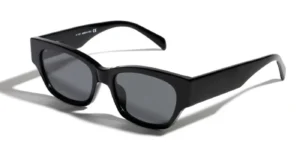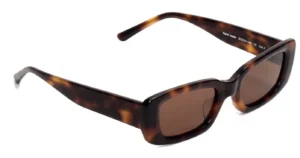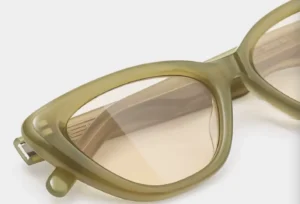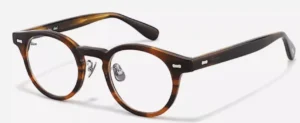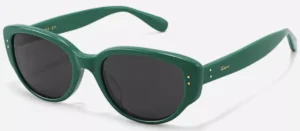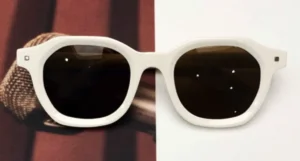Introduction
Sunglasses are vital accessories that go beyond just fashion statements. With ultraviolet radiation from the sun being a constant health threat, quality sunglasses must provide ample UV protection. In this comprehensive guide, Professional sunglasses manufacturers explore the UV400 protection rating, how sunglass lenses filter and attenuate light, recommended tinting for different activities, and the various categories of sunglasses defined by their lens properties.
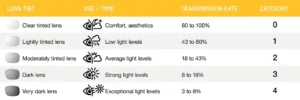
By the end, you’ll understand critical specifications like UV400 ratings, visible light transmission percentages, polarization, and impact resistance that consumers should evaluate when selecting sunglasses. You’ll be able to make informed choices for the right eyewear and lenses to protect your vision when outdoors. Let’s dive into the science behind sunglasses lens technology!
Chapter 1 – Ultraviolet Radiation and UV400 Ratings
Ultraviolet (UV) rays from the sun contribute to eye conditions like cataracts and macular degeneration over time. Quality sunglasses block these invisible yet harmful rays.
UV Types:
- UVA – Longer rays that penetrate deep affecting skin and eyes. Linked to aging and genetic damage.
- UVB – Burn-causing rays blocked by ozone. Associated with cataracts.
- UVC – Most absorbed by the atmosphere and doesn’t impact eyes significantly.
UV400 Ratings – This indicates lenses block 100% of UVA and UVB light waves up to 400nm, providing complete ultraviolet protection critical for eye health. If sunglasses don’t mention UV400 or 100% UV protection, be skeptical of claims. Inferior lenses may only filter some UVA/UVB ranges.
The FDA and vision groups like The Vision Council recommend sunglasses offer full UV400 blocking. Don’t settle for less when the health of your eyes is on the line.
Chapter 2 – Visible Light Transmission Percentages
Visible light transmission percentage indicates how much visible (not UV) light passes through sunglass lenses. Lower percentages denote more darkening. Common ranges:
- 80-100% – Minimal tinting. Some fashion glasses are in this range.
- 43-80% – Medium reduction in brightness. Filters some harsh light.
- 15-43% – Significant light reduction. Ideal for very bright environments. Still usable for driving and indoors.
- 8-15% – Extra dark lenses for the greatest glare cutting. Best for intense sunlight like beaches, snow, and lakes. Not recommended for driving or night use.
Consider planned activities and conditions when choosing visible light transmission percentages. Increasing darkness makes bright light more bearable but reduces visibility in dim environments.
Chapter 3 – Polarization, Reflected Light, and Sunglasses
Reflected sunlight often creates distracting glare. Polarized lenses reduce this through a special filtering process:
What is Polarization? – Light naturally oscillates on a wavy electromagnetic plane. Polarizing filters only allow light orientated in one direction to pass, blocking reflection off flat surfaces.
Benefits:
- Cuts reflective glare off water, snow, roads, and cars.
- Deepens blue skies and reduces haze.
- Improves contrast and definition.
Downsides:
- Can make reading screens and monitors more difficult by interfering with display polarization.
- Not recommended for mountain driving as they can obscure ice patches on roads.
If fighting frequent glare, polarization can significantly improve visual clarity – just be mindful of potential interference with digital displays.
Chapter 4 – Recommended Sunglass Lens Tinting by Activity
Tinting tailors lenses for different uses by selectively filtering or darkening specific light wavelengths:
Gray/Green – Universal tint maintaining color balance and clarity, great multi-purpose option. Provides true color definition. Recommended for driving. Green assists with glare.
Brown – Excellent for high-glare activities. Mutes excessive brightness while increasing contrast. Works well on water and snow.
Yellow/Amber – Filters hazy blue light and enhances contrast. Recommended for overcast days, foggy conditions, and night driving. Improves depth perception.
Rose-Colored – Minimizes bright lights and glare while boosting contrast. Makes green/blue tones pop. Recommended for water sports and lawn/snow care.
Red/Vermillion – Heightens contrast between greens and browns/earth tones. Recommended for golf, clay shooting, baseball, and hunting.
Consider activity lighting conditions and color contrast needs when selecting tints. Match lens properties to how and where they will be used most.
Chapter 5 – Material Considerations for Sunglass Lenses
Lens substrates impact optics, durability, and weight:
Glass – Unmatched optical clarity, scratch resistance, and precision optics. Tends to be heavier.
Polycarbonate – Extreme impact resistance. Weighs 50% less than glass. Slight optical distortion. Best for sports.
High-Index Plastics – Lightweight and thin for neutral buoyancy in water. Reduces distortion of strong prescriptions. Good durability.
Trivex – Premium impact-resistant urethane material as a lightweight glass alternative. Enhanced clarity over polycarbonate.
NXT – Polyurethane lenses are 20% lighter than polycarbonate. Impressive durability and optics.
SR-91 – Superhydrophobic lens material that repels water, oil, and fingerprints. Anti-scratch.
Consider activity intensity and weight needs when selecting lens material. Polycarbonate makes sense for sports while glass provides unrivaled clarity for more casual use.
Chapter 6 – Eyeglass Prescription Lens Tinting Options
Adding tint to corrective lenses:
Factory Tinting – Optical labs can incorporate uniform tinting into lenses when fabricated. Gradients fade from dark top to clear bottom.
Clip-On Tints – Flip-up secondary lenses attached by magnets or frames that snap over regular glasses as needed. Provides flexibility.

Photochromic – Lenses that transition from clear indoors to dark tinting in sunlight thanks to light-reactive compounds. Convenient automatic adjustable tinting.
Spray Tints – Tinted transparent dyes sprayed onto lens perimeter edges maintain a clear central optical viewing area.
Prescription holders desiring tint have several options for balancing indoor and outdoor vision needs. Consider lifestyle and activities when selecting methods.
Chapter 7 – Measuring Sunglass Lens Protection Levels
Critical specifications beyond just tinting include:
- UV Protection – FDA requires UV400 labeling if blocking 99-100% UVA/UVB under 400nm. Look for verification of complete protection.
- Impact Resistance – ANSI Z80.3 testing measures the force eyewear can withstand. Basic, High-impact, and Ballistic ratings. Sports require durable frames and lenses.
- Abrasion Resistant Coatings – Layered coatings protect from scratching. Tested by “Bayer Abrasion Resistance Test” standards.
- Refractive Index – Indicator of visual clarity. Higher is better. 1.9 or greater is recommended for sports.
- Polarization Efficiency – Greater than 99% ensures effective polarization.
Carefully scrutinizing labels and ratings separates robust protective lenses from more fashionable cheap sunglasses. Prioritize safety.
Chapter 8 – Sunglass Lens Coating Options
Advanced coatings enhance performance:
- Anti-Reflective – Reduces distracting glare and reflections. Improves clarity.
- Hydrophobic/Oleophobic – Repels smudges, oils, and water. Easier cleaning.
- Anti-Fog – Prevents condensation buildup. Popular on sport and kids’ eyewear.
- Scratch Resistant – Protects exterior lens surface from abrasions.
- Anti-Static – Prevents dust particle attraction for less cleaning.
- Infrared Blocking – Reflects heat-inducing rays for comfort in intense light.
- VLT-Optimizing – Adjusts visible light transmission percentages.
- Night Driving – Reduces headlight glare.
Medical experts recommend lenses with multiple protective coatings beyond just UV blocking for the fullest safety.
Chapter 9 – Sunglass Lens Shapes and Curvatures
Lens geometries affect aesthetics and ergonomics:
- Base Curve – Measure of lens front curvature. Flatter looks more stylish. Steeper increases field of view.
- Base Shape – Rounded, oval, rectangular, and other shapes. Impacts fit, coverage, and look.
- Front Surface Cylinder – Front curvature added for prescription correction and wrap.
- Back Surface Curve – Backside bend improving peripheral vision. Varies between frames and Rx needs.
- Lenticular Cut – Bi-convex cross-section that further contours the lens for enhanced wrap coverage.
- Frame Groove – Edge shape cut matching the frame that holds each lens.
Balancing technical optical requirements with ideal secure fitting makes lens shaping an art.
Chapter 10 – Prescription Inserts for Sports Sunglasses
For active wearers needing vision correction:
- Clip-In – Lenses click into grooves in sunglass frames when needed. Easily removable. Available for many major sports brands.
- Adhesive Inserts – Stick directly to the back interior of sunglass lenses. Reusable and easily removable.
- Magnetic-Rx – Rx lenses attach via embedded magnets on the sunglass interior. Convenient switching.
- Prescription Insert Frames – Small secondary frame integrated into main sunglasses to hold prescription lenses.
- Custom Lab Rxing – Optical labs can directly grind Rx prescriptions into sports sunglass curved lenses.
Insert options provide flexibility to match varied activities and eyewear needs. Wearers can maintain excellent vision without switching glasses.
Chapter 11 – Night Driving Sunglasses
Yellow-tinted lenses optimize night driving visibility:
- Blocks Blinding Headlights – Yellow lenses filter bright white light that scatters and reduces contrast in low light. Reduces glare.
- Heightens Visibility – Improves views of road lines, signs, pedestrians, and animals by sharpening contrast.

- Enhances Depth Perception – Boosts distance judgment compared to clear lenses.
- Maintains Color Recognition – Still allows some color visibility, unlike dark polarized lenses. Important for spotting road signs.
Look for visible light transmission percentages around 50-75% for a moderate reduction in brightness at night. Going too dark creates further visibility issues.
Chapter 12 – Sunglass Styles and Frame Choices
Frame options balance fashion, fit, and function:
- Aviators – Teardrop-shaped mirrored lenses in thin metal frames. Classic style with vintage appeal.
- Wayfarers – Trapezoidal shaped plastic frames mid-century style. Iconic tapered look.
- Cat Eye – Curved feminine dramatic upper frame sweep. Great coverage.
- Round – Circular John Lennon-esque look. Retro-inspired large lenses.
- Wrap Around – Lenses gently curve around the face. Ideal for outdoor sports use.
- Oversized – Larger lenses expanded coverage. Trendy statement look.
- Rectangle – Reserved classic shape. Famously fashionable.
Geometry, size, and materials offer diverse styling for different face shapes and individuality.
Chapter 13 – Best Sunglasses for Small Faces
Those with petite features should seek scaled-down frames:
- Lightweight Materials – Opt for thin metals, nylon, or rimless to avoid overwhelming facial proportions.
- Smaller Lens Size – Look for around 50mm wide or less for an ideal fit. Oversize frames overwhelm dainty faces.
- Low-Profile – Seek low bridges and thin arms that don’t stick out substantially.
- Oval Lens Shape – Softer rounded edges are less harsh than stark angular styles on small faces.
- Translucent or Transparent Frame Colors – Visually minimizes heavy dark frames.
- Minimal Bridge – Restrict bridge width to 20mm or less so it doesn’t dominate face width.
The right-proportioned frames highlight rather than hide petite features.
Chapter 14 – Best Sunglasses for Wide Faces
Those with broad features should balance and complement their attributes:
- Rectangular Lenses – Elongated horizontal line visually breaks up wider face shapes.
- Bold Fifteen – Opt for thicker, bolder frames that don’t get overpowered by prominent facial structures.
- Darker Frame Colors – Black, bold hues minimize the appearance of wider cheekbones. Avoid pale frames.
- Embrace Aviators – The teardrop shape and clean lines complement square jaws.
- Limit Bridge Height – Keep frames low on the nose to reduce visible vertical height.
- Ombre Fade Lenses – Gradient fading to a lighter bottom minimizes lower facial width.
Strategic shape and color selections create flattering optical illusions for wide bone structures.
Chapter 15 – Best Sunglasses for Long Faces
Those with oblong narrow features should:
- Seek Round or Oval Lenses – Softens sharp angles and adds width.
- Consider Cat Eye – Angled upsweep provides the illusion of width across cheekbones.
- Embrace Oversized – Proportionally large frames add dimension.
- Thicker Frames – Thick bold frames so the long face isn’t overwhelmed.
- Add Visual Interest – Seek embellishments, prints, and patterns to balance the elongated look.
- Size Matters – Larger sizes help fill narrow spaces. But don’t overdo it.
- Gradient Lenses – Fade from a dark top to lighter bottoms for a tapered effect.
The right shapes, sizes, and colors keep sunglasses in scale with more linear facial attributes.
Chapter 16 – Best Sunglasses for Heart-Shaped Faces
Flatter a wide forehead and feminine jawline by:
- Choosing Rimless or Translucent Frames – Minimizes overwhelming upper face.
- Trying Round Styles – Softens overall look and sharp chin point allure.
- Adding Width at Temples – Broad arms add needed horizontal for heart tapering effect.
- Embracing Cat Eye – Slight upsweep plays up eyes and balances broad forehead.
- Avoiding Oversize – Keep lenses proportional to prevent dominating delicate features.
- Darkening Temples – Fade colors darker at the ends to emphasize cheekbones.
- Gradient Lenses – Dark at top, lighter at bottom minimizes wide upper facial third.
Strategic tints, shapes, and materials help create the illusion of ideal facial symmetry.
Chapter 17 – Best Sunglasses for Round Faces
Rectangular specs elongate and add definition to soft circular faces:
- Rectangular is Key – Horizontal straight lines and corners lengthen the appearance.
- Embrace Rimless – Open up the look and reduce roundness.
- Make Temples Disappear – Clear or skin-toned arms draw less attention.
- Add Bold Brows – Define upper rims in a darker color for emphasis.
- Gradient Lenses – Fade darker at the bottom to play down rounded jaw areas.
- Avoid Retro Rounds – Stick with rectangular and cat-eye shapes.
- Skip Ombre Lenses – Fading darker at the top will accentuate roundness.
Offsetting curves with lines and angles brings proportionate balance.
Chapter 18 – Best Sunglasses for Square Faces
Softer rounded edges on strong jaws help break up boxiness:
- Oval Lenses – Circular curves offset rigid edges for balance.
- Avoid Rimless – Frames help downplay the natural angles.
- Embrace Curves – Caterpillar or browline styles soften.
- Detailed Temples – Patterns divert focus from the angles.
- Gradient Lenses – Dark tops taper facial length.
- Experiment with Colors – Fresh hues on frames brighten up chiseled features.
- Skip Retro Rectangles – Avoid enhancing the boxiness.
Symmetry comes from the right mix of rounded lenses with low-profile frames.
Chapter 19 – Best Sunglasses for Triangle Faces
Widen narrow lower proportions for aesthetic balance:
- Cat Eyes – Angled upweeps add width to the cheekbones.
- Rounded Edges – Circular lenses soften pointy chin area.
- Bold Temples – Thick brightly colored arms attract attention downwards.
- Ombre Lenses – Gradient darkens lower third minimizing a pointy chin.
- Avoid Rimless – Frames help balance bottom heaviness.
- Limit Bridge Size – Keep the top half in check with low profile bridge.
- Rectangular Lenses – The horizontal line visually widens the bottom.
Drawing the eye outward and downward helps offset a disproportionately wide top third.
Chapter 20 – Best Sunglasses for Thin or Prominent Noses
Frames can either downplay or accentuate nose structure:
Downplaying Noses:
- Rimless Frames – Keeps central focus off the nose profile.
- Low Set Bridges – Minimizes height drawing attention.
- Muted Colors – Grays, blacks, or transparent frames blend in.
- Cushion Pads – Provide comfort on the bridge and nostrils.
Accentuating Noses:
- High Bridges – Emphasize height and bridge width.
- Bold Colors – Bright thick frames highlight central features.
- Novelty Shapes – Fun bridge cutouts and circular nose pads play up characteristics.
Finding the most flattering interplay between frame profiles and your attributes makes all the difference.
Chapter 21 – Sunglasses for Protecting Children’s Eyes
Critical considerations for kids’ eyewear:
- Durability – Flexible frames that won’t crack or break if stepped on or dropped. Polycarbonate lenses.
- Adjustability – Ability to tweak fit as kids grow. Adjustable nose pieces and arm lengths help.
- Comfort – Flexible materials that won’t be heavy or pinch skin as children play and run around.
- Full UV Protection – Don’t settle for anything less than 100% UVA/UVB blocking in youth lenses.
- Impact Protection – Look for high ratings on impact tests to protect active kids’ eyes.
- Styles – Trendy colors and shapes make them more likely to wear them consistently.
Guarding developing vision starts with responsibly protecting children’s eyes at a young age through proper UV-blocking eyewear.
Chapter 22 – Extra Large Sunglasses
Oversized sunglasses provide both fashion and function:
- Increased Shielding – Bigger lenses equals more protection from sun exposure all around.
- Surfer Chic Style – Big frames evoke a laidback beachy aesthetic.
- Added Privacy – Darker and more expansive lenses allow increased anonymity.
- Retro Appeal – Revisit the glamour of Hollywood starlets and mid-century sophistication in a bold updated way.
- Makes a Statement – Oversized frames convey confidence and individuality.
Go boldly big to protect your eyes in cool incognito style with XL modern sunglasses.
Chapter 23 – Small-Sized Sunglasses
Fun micro sunnies with concentrated cool:
- Portable – Compact sizes are ultralight and fit easily in any pocket.
- Accentuate Your Face – Petite frames draw focus to your best facial features.
- Make a Statement – Playful vibrant colors and shapes show off your unique personal style.
- Versatile Styling – Easy to mix and match small sunglasses with any outfit year-round.
- Budget Buys – Smaller frames often come at lower price points while still providing UV protection.
- Unisex Appeal – Small sizes look great on all genders.
While offering less coverage, micro sunnies maximize awesome aesthetics.
Chapter 24 – Bold and Funky Sunglass Frames
Make a visual impact and show your personality through frames:
- Thick Acetates – Multi-layered laminated patterns and colors create visual depth.
- Bold Shapes – Geometric angles, butterfly, cat eye, and other dramatic silhouettes.
- Metallic Colors – Mirrored or metallic coated frames shine attractively.
- Bold Patterns – Wood grains, animal prints, and abstract designs energize looks.
- Novelty Details – Crystals, studs, cutouts, and other embellishments express uniqueness.
Don’t just fade into the background – let vibrant bold frames reflect your confidence and vibrancy.
Chapter 25 – Vintage Inspired Sunglasses
Classic retro frame shapes that never go out of style:
- Wayfarers – Iconic elegant tapered styling from the 1950s. Ray Ban’s most famous model.
- Aviators – Teardrop-shaped lenses in thin metal wire frames evoke old-school pilot cool.
- Cat Eyes – Dramatic upswept top profile accentuates feminine allure. Hints at Hollywood glamour.
- Round Lennon Styles – Large perfectly circular lenses inspired by John Lennon’s legendary look.
- Browlines – Bold upper border in a contrasting color reminiscent of early plastic frames.
- Shields – Single large lens evokes sporty motocross-style from the 1980s.
Updated takes on timeless silhouettes stay perpetually on-trend. Vintage allure never fades.
Chapter 26 – Limited Edition and Luxury Sunglasses
Upscale frames heighten exclusivity:
- Rare Materials – Buffalo horn, pure titanium, sterling silver, gold, and platinum mark preciousness.
- Bejeweled – Genuine or synthetic diamond, ruby, sapphire, and crystal embellishments.
- Limited Production Runs – Restricted batches with serial numbered pairs.
- Handmade Quality – Meticulous cutting, shaping, and polishing ensure perfection.
- Branded Artistry – Recognizable styles distinguish coveted fashion houses.
- Luxe Packaging – Leather or velvet cases carry cachet.
- Celebrity Endorsements – Big star power partnerships promote prestige.
Blending fine craftsmanship with exclusivity evokes luxury distinction.
Chapter 27 – Cool Sunglass Cases
Cases protect style while making a statement:
- Leather Cases – Classic material with supple感觉 that develops a patina. Conveys sophistication.
- Designer Fabric Cases – Recognizable elite fashion house prints signal status.
- Hard Cases – Durable lightweight aluminum, polycarbonate, or plastic valuably protects lenses and frames.
- Novelty Cases – Fun materials like wood, mother of pearl, abalone, and shell offer artisanal eco-friendly distinctiveness.
- Vintage Cases – Classic mid-century styling in materials like enamel and chrome wire mesh.
- Personalization – Custom laser engraving of names or logos aids identification.
Let your sunglass case convey personal flair too with choices that inspire you to take your shades everywhere.
Chapter 28 – Sunglasses with Readers
Multifocal sunglasses meet multiple visual needs:
- Bifocals – Separate prescription zone at the bottom for near vision tasks.
- Trifocals – Intermediate vision segment also added.
- Progressives – No-line transition from distance to reading.
- Magnification – Picks in typical +1.0 to +3.0 progression.
- Rx-able – Some brands like Foster Grant let you insert your own near-vision Rx lenses.
- Clear Zone – The reading area is kept transparent.
Multifocal sunglasses maintain clarity of vision regardless of lighting.
Chapter 29 – Shooting and Safety Glasses
Serious protection for hazardous hobbies:
- Ballistic Impact Resistance – Meets military specs to withstand extreme projectile impacts from shooting or shrapnel.
- Hard Coatings – Abrasion-resistant exterior lens coatings prevent scratches.
- Secure Fit – Comfortable padded adjustable nose and ear pieces grip firmly in place.
- Venting – Strategic airflow prevents fogging and cooling.
- Side Shields – Prevent particles entering at angles impacting the eyes or face.
Don’t take chances with questionable safety – equip properly for dangerous hobbies using lab-tested protective specs.
Chapter 30 – Sunglasses for Large Heads
Those with bigger craniums should seek:
- Adjustable nose pads – Wider spacing apart accommodates broad noses.
- Flexible joints – Hinges that allow arms to widen further provide a comfortable fit clearing ears.
- Longer arms – Maximum expanded arm length keeps pressure off the side of bigger heads. Look for at least 135mm.
- Lightweight – Reduces pressure and slipping on the higher surface area.
- Durable – Strong frames and arms prevent breakage.
Get the right sunglass fit to comfortably protect any size noggin.
Chapter 31 – Sunglasses for Small Heads
Frame choices to flatter petite skull sizes:
- Shorter arms – Keep overall proportions in check on a smaller canvas. Around 120mm in length.
- Low weight – Prevent bigger feeling frames from overwhelming a diminutive head.
- Plastic frames – Flexible bendable styles conform better to curve around a small cranium.

- Adjustable gripping nose pieces – Ensure a secure fit on narrower nose bridges.
- Flexible hinges – Allow frames to contour a compact face without pressing inward uncomfortably.
- Smaller sizes – Scale down lenses, bridges, and arm pieces so they don’t overpower tiny features.
Stay proportional on dainty heads with scaled-down sizing that doesn’t squeeze or slip.
Chapter 32 – Environmentally Sustainable Sunglasses
Eco-conscious production and materials include:
- Recycled Metals – Brands like Roka use recycled steel. Creates 60% less CO2 emissions.
- Plant-Based Acetates – Derived from renewable cotton, wood, or sugarcane rather than petroleum.
- Bamboo Frames – A natural growing renewable material alternative.
- Biodegradable Frames – Brands like Plastic. Make frames from castor beans that decompose freely. Promotes circular lifecycles without toxic PVC.
- Lens Recycling – Brands like LensCrafters recycle old lenses into new prescription blanks.
- Charitable Initiatives – Warby Parker partners sustainably producing glasses and distributing them to those in need.
Feel good choosing brands that care about the entire lifecycle.
Chapter 33 – Operating an Optical Shop Business
Key elements for retail success:
- Location – Ideally visible either high foot traffic or anchor store proximity.
- Inventory – Range of designer brands and niche offerings catering to local tastes.
- Equipment – Lensmeters, lens edging, and fabrication tools, frame warmers, adjustable pliers.
- Staff – Hire detail-oriented opticians good at client consultations.
- Services – Eye exams, contact lens fittings, urgent repairs. Consider onsite finishing lab.
- Pricing – Discount and luxury options appeal to a wide customer range.
- Marketing – Social media, local events, eye care partnerships.
The right mix of convenience, selection, and services builds a trusted neighborhood vision resource.
Chapter 34 – Troubleshooting Problems Ordering Custom Prescription Sunglasses
Common prescription sunglass issues and fixes:
Blurry Vision
- Check measurements – pupillary distance, and heights – were taken correctly. Redo if necessary.
- Verify optical center alignment is precisely centered to your pupils. Redo lenses if off.
Imperfect Fit
- Adjust nose pads, and earpiece angling until frames sit evenly.
- Carefully rebend frames until properly contoured to your facial anatomy.
Delays
- Ask the lab for a realistic timeline and plan accordingly. Rush fees are usually available.
- Get progress updates from optical staff. Be patient; quality takes time.
High Cost
- Compare pricing from various lens materials and coating options to find savings.
- Consider buying quality frames separately and then having a local optical shop insert Rx lenses.
With custom Rxs, great final vision requires getting measurements nailed down.
Chapter 35 – Troubleshooting Problems Ordering Prescription Glasses Online
Challenges buying glasses online and tactics to overcome them:
Inaccurate Prescriptions
- Always start by re-verifying your most recent correct Rx numbers. Old Rxs cause issues.
Poor Lens Fit
- When receiving, compare pupil centers against optic centers. Remake lenses if misaligned.
Frame Quality Issues
- Understand the risks of buying cheaper frames. Inspect craftsmanship carefully upon arrival.
Lacking Adjustments
- DIY adjustments like nose pad bending, earpiece tweaking, and gentle heating/bending of frames to customize the fit. Watch tutorials.
Check Returns
- Reputable vendors accept returns and remakes. Confirm policies before ordering. Understand restocking fees.
Buying glasses online can bring savings if you verify details and DIY final tweaks. Vet vendors carefully.
Chapter 36 – How Lens Coatings Enhance Sunglass Performance
Special lens treatments optimize utility:
- Polarization – Cuts horizontal glare from flat surfaces like water or roadways. Color saturation and sharpness.
- UV Protection – Block 100% of UVA/UVB rays up to 400nm. Defends against sun damage to eyes.
- Hydrophobic – Causes water to bead up and roll off lenses for easy cleaning. Minimizes streaks.
- Scratch Protection – Clear top layers shield exterior lens surfaces from fine abrasions.
- Anti-Fog – Prevents condensation for sports, kids, or humid condition eyewear.
- Infrared Barrier – Protects eyes from heat-inducing light wavelengths.
- Night Driving Tint – Reduces glare from headlights after dark.
Layering lenses in treatments creates sunglasses exceeding basic tinting alone.
Chapter 37 – Which Sunglass Brands Offer Repairs and Spare Parts
Seek eyewear companies promoting longevity:
- Ray-Ban – Offers replacements of any parts damaged or worn out. Items like lenses, nose pads, hinges, and arms.
- Oakley – Through registration, offers discounted replacement lenses and parts to restore performance and extend the life of frames.
- Randolph Engineering – Sells all individual frame components for military styles to enable ongoing use with repairs.
- Maui Jim – Extensive spare parts available for their frames and lenses including Rx insert options.
- Costa Del Mar – Provides replacement nose and ear pieces, cases, and lens options.
- Persol – Conducts repairs on older models to preserve treasured vintage frames in service.
- Warby Parker – Features lifetime lost and broken policy with small fees.
Repair-friendly brands build loyalty by promoting quality and accessibility over frequent disposable replacements.
Chapter 38 – Troubleshooting Problems When Sunglasses Make Your Nose Hurt
Sore nose woes and remedies:
- Nose pads misaligned – Evenly center and space pads across the bridge.
- Pads lack grip – Use adjustable rubber pads that can pinch tighter.
- Frames too loose – Adjust bend so pads press firmly to grip without sliding.
- Nose pads too tight – Loosen pad arms so they don’t pinch excessively.
- A bridge too wide – Seek frames with a lower profile bridge crossing the nose.
- Nose contour mismatch – Try different adjustable pad shapes that best hug your nose anatomy.
- Too much weight – Opt for lightweight metals or plastic frames to decrease pressure.
- Skin irritation – Seek hypoallergenic pads/frames if metal and plastics cause irritation.
Carefully identifying and tweaking contact points brings great comfort.
Chapter 39 – Troubleshooting Problems of Sunglasses Hurting Your Ears
Ear pain relief strategies include:
- Adjust earpiece angle – Angle back ends downward to relieve upper ear pressure points.
- Shorten earpieces – Carefully cut excess arm length if extended ends push on ears.
- Pad earpieces – Add soft cushion foam or tubing to decrease friction on contact points.
- Loosen fit – Slightly expand the tightness of earpieces digging into the sides of the head.
- Try different materials – Alternate between plastic, silicone, and rubber earpieces if certain materials irritate.
- Limit wearing time – Build up durability by gradually increasing sunglass wearing each day.
- Consult a doctor – Persistent raw sore spots may indicate infection needing medical treatment.
Alleviating discomfort fosters consistent wear protecting you outdoors.
Chapter 40 – Troubleshooting Problems of Sunglasses Fogging Up
Quick fog reduction tactics:
- Adjust position – Tilt glasses forward just slightly so your eyes peer downwards instead of straight ahead. Promotes air circulation.
- Ensure nose pad seal – No gaps should exist between pads and nose contours to prevent breath from sneaking upwards from below.

- Clean thoroughly – Use dish soap and water to remove greasy residues left by sunscreens and cosmetics minimizing condensation.
- Apply anti-fog spray – After cleaning, use hydrophobic solutions to create a water-repellent barrier. Reapply frequently.
- Switch lenses – Certain materials like polycarbonate fog more readily. Try different lens materials or add anti-fog coating.
Fog-free visibility makes sunglasses far more comfortable and usable year-round. Never scrub lenses when wet – only gentle wiping when dry.
Chapter 41 – Troubleshooting Problems of Sunglasses Scratching
Prevent scratch damage:
- Use case – Keep sunglasses in hard protected case when not worn or tossed in a bag. Prevent scratches from items jostling together.
- Avoid overcrowded bags – Isolate sunglasses in your own pocket or pouch so they can’t rub up against abrasive objects while being stored or carried.
- Add scratch-resistant coating – Lab apply or DIY apply clear scratch-resistant top layer offering protection from fine debris scratches.
- Use microfiber – Always store, wipe, and handle lenses with microfiber cloths to avoid fine dust scratches from paper towels or fabrics.
- Hold by frames – Pick up sunglasses by frames rather than lenses to reduce smudges and risk of scratching.
A few handling precautions help keep costly lenses looking pristine.
Chapter 42 – How to Make Non-Prescription Sunglasses Into Prescription
Options for adding Rx:
Pinhole Glasses – Cheap cardboard sunglasses with tiny pinhole cutouts that enhance the depth of focus for mild prescriptions as a temporary solution. Not very durable.
Clip-On Lenses – Flip-up Rx lenses mount via clip or magnets onto regular sunglasses. Allows easy switching. Wide powers available.
Stick-On Lenses – Adhesive-backed plastic or gel lenses placed onto the back of sunglass lenses. Offered online and in some optical shops. Limited powers.
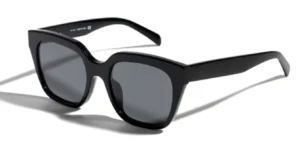
Inserts – Custom prescription plastic inserts fit into grooves or channels installed into certain major sports sunglass brand frames.
DIY Kits – Send your own frames to a lab that cuts Rx plastic lenses with beveled edges to adhere to sunglass frames at home.
Permanent Rx – Optical shops can directly surface grind prescriptions into curved non-Rx sunglass blanks.
Summary
- Sunglass lens technology has advanced tremendously, enabling specialized tints, durable coatings, and prescription options that protect the eyes while enhancing outdoor recreation.
- Know what ratings like UV400 blocking and visible light transmission percentages indicate to select lenses suited for your needs.
- Polarization, anti-reflective treatments, and hydrophobic coatings each solve specific issues like reducing glare, increasing contrast, and resisting smudges.
- Match lens colors and activities – brown/gray for driving, yellow for overcast days, rose for water sports, and so on based on lighting conditions.
- Frame size and shape choices can complement facial structure and proportions. Seek flatters.
- Custom prescriptions are now possible for non-Rx frames through DIY kits, stick-on lenses, inserts, or permanent fabrication.
With so many lens and frame innovations now available, finding tailored solutions for priorities like vision correction, protection level, durability, and style makes sunglasses accessible for nearly any need, face, or activity. Know your specifications and do your research to purchase eyewear that uniquely enhances how you see the world.
